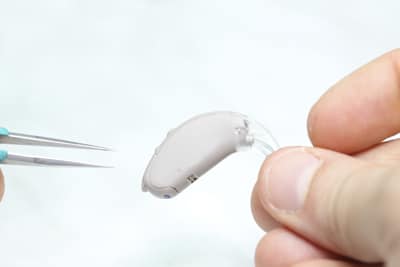
Most audiologists send hearing instruments to the manufacturer for even the most minor repairs. But, at Hearing Aid Services of Hollywood, Jeff has developed a comprehensive on-site repair facility (see the photo above of our repair area). Jeff is capable of making repairs that range from simple wax extraction to the replacement of defective components. If your instrument can be repaired in the office, Jeff will be more than happy to take the necessary steps to help you avoid the inconvenience of a seven to ten-day wait for a factory repair.
A Hands-on Kind of Guy
As a child, Jeff was always taking apart and reassembling things. He avidly engaged in woodworking, building racing engines, constructing scale models and electronics kits, and home improvement. Today, his projects have become miniaturized in the form of hearing aids. The same skills developed through a lifetime of assembling things are applied when he modifies and repairs hearing instruments. Using fine soldering and wiring techniques, his service is guaranteed to meet the manufacturer’s specifications for each make and model of hearing aid.
Jeff Grama, our audiologist, provides a complete hearing service to his patients.
“He (Jeff Grama) is without a doubt the most skilled (audiologist) not only because of his expertise with selection of the device, but also because he is a specialist at repairing hearing aids. This is ESSENTIAL. I’ve never been to an audiologist that could fix a cracked mold in-house, for example, usually for any type of repair work. You’re basically without a hearing aid while the layman audiologist sends it back to the manufacturer for weeks at a time. Not a good feeling when your hearing aid is your lifeline to the outside world.”
Joseph L., Venice, CA
What Can You Do When Your Hearing Aid Stops Functioning?
Hearing aids follow Murphy’s Rules of Reasoning. That is, when something is going to go wrong, it will happen at the most inopportune time. However, don’t assume the worst! There are some simple things you can do when your hearing aid doesn’t seem to work properly.
The most common reason a hearing aid will not work is that it’s plugged with earwax or other debris. A plug of wax will prevent the sound from escaping from the speaker port of an in-the-ear aid or the earmold of a behind-the-ear aid, and you’ll think the aid is dead. However, you can remove the wax plug with the brush or wax loop that came with your hearing aids. If you don’t have cleaning tools, you can use the pointed end of a straight pin to gently dig the wax out.
For those of you who have in-the-ear hearing aids that have wax guard filters installed, the cleaning process is slightly different. The filters are the tiny white plugs that fit into the end of the hearing aid that you insert into your ear canal. Replacement filters are in a 2-inch by 3-inch white or gray packet. When you snap open the top of the packet, you’ll find some black sticks.
Remove one of the sticks and you’ll notice a small white piece on the tip. This is the replacement filter. Take out the old filter with the flattened end of the black stick by pushing it into the old filter and pulling it straight out of the aid. Then, flip over the stick and gently slide the replacement filter into the spot the plugged filter occupied. Usually, this is all that it takes to get your instrument functioning again.
For behind-the-ear users, the problem is often a moisture plug inside of the tubing where the tube inserts into the earmold. You can break the moisture bubble by holding the upper portion of the aid firmly where the earmold tubing attaches to your instrument. Shake it two or three times, as if you were shaking down an old-fashioned thermometer. This force will usually break the moisture bubble and you’ll be back in business.
Call Hearing Aid Services of Hollywood at (323) 463-7109 for more information or to schedule your appointment today.

